Leadership and Management: Qualities, Development, and Differences
VerifiedAdded on 2021/02/21
|13
|3715
|22
Report
AI Summary
This report delves into the multifaceted concepts of leadership and management. It begins by identifying the core qualities of a successful leader, emphasizing the importance of learning, trust-building, team formation, goal orientation, performance evaluation, and effective communication. The report then explores how good leadership can be developed, highlighting the significance of active involvement, situational awareness, and continuous self-improvement. A key section of the report differentiates between leadership and management, clarifying that management focuses on planning, organizing, and controlling activities, while leadership involves guiding and influencing others. The report also touches upon various leadership theories, including individual, contextual, and relational theories, offering a comprehensive view of leadership styles and their applications. Overall, the report provides a detailed analysis of leadership and management, offering valuable insights for aspiring leaders and managers.
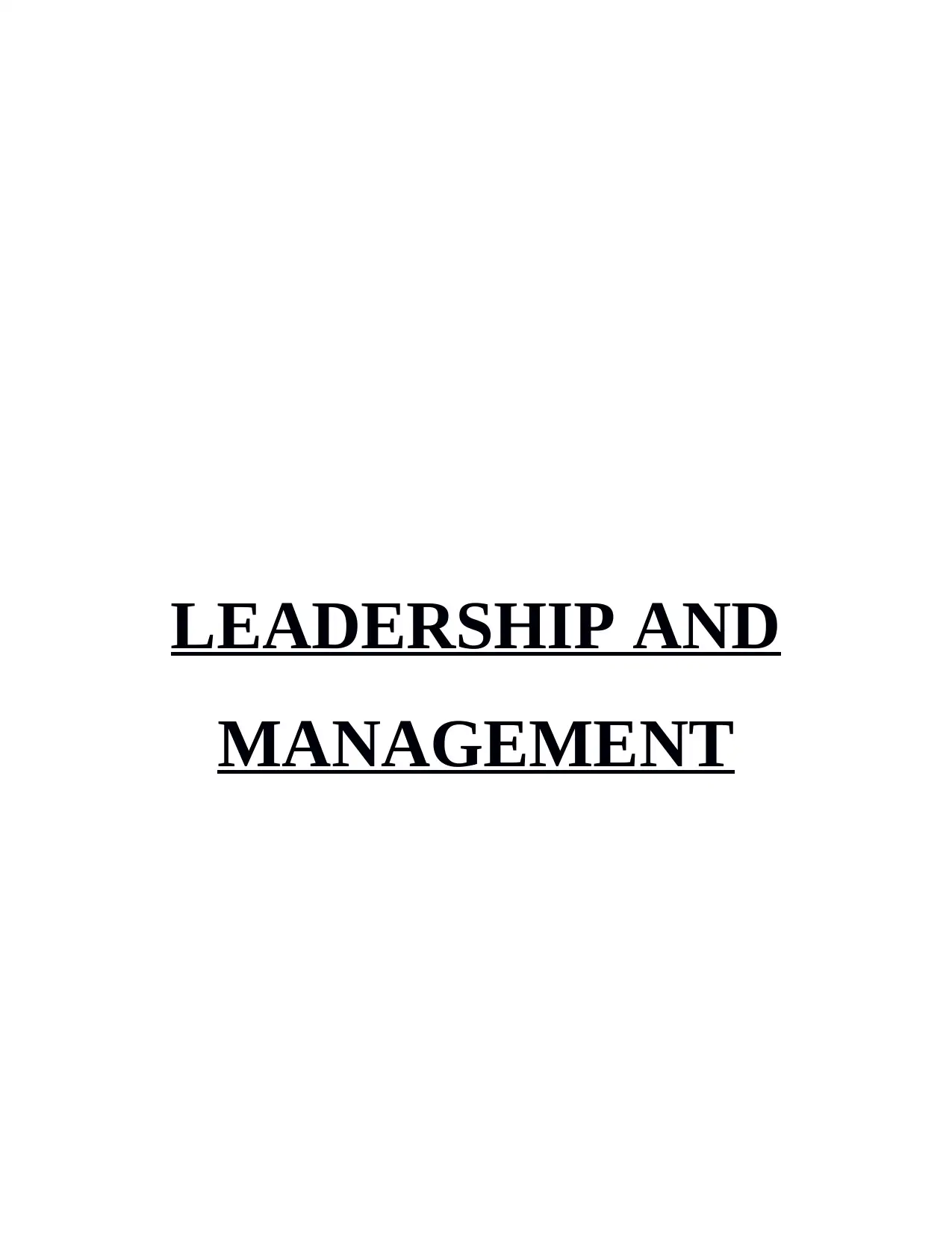
LEADERSHIP AND
MANAGEMENT
MANAGEMENT
Paraphrase This Document
Need a fresh take? Get an instant paraphrase of this document with our AI Paraphraser

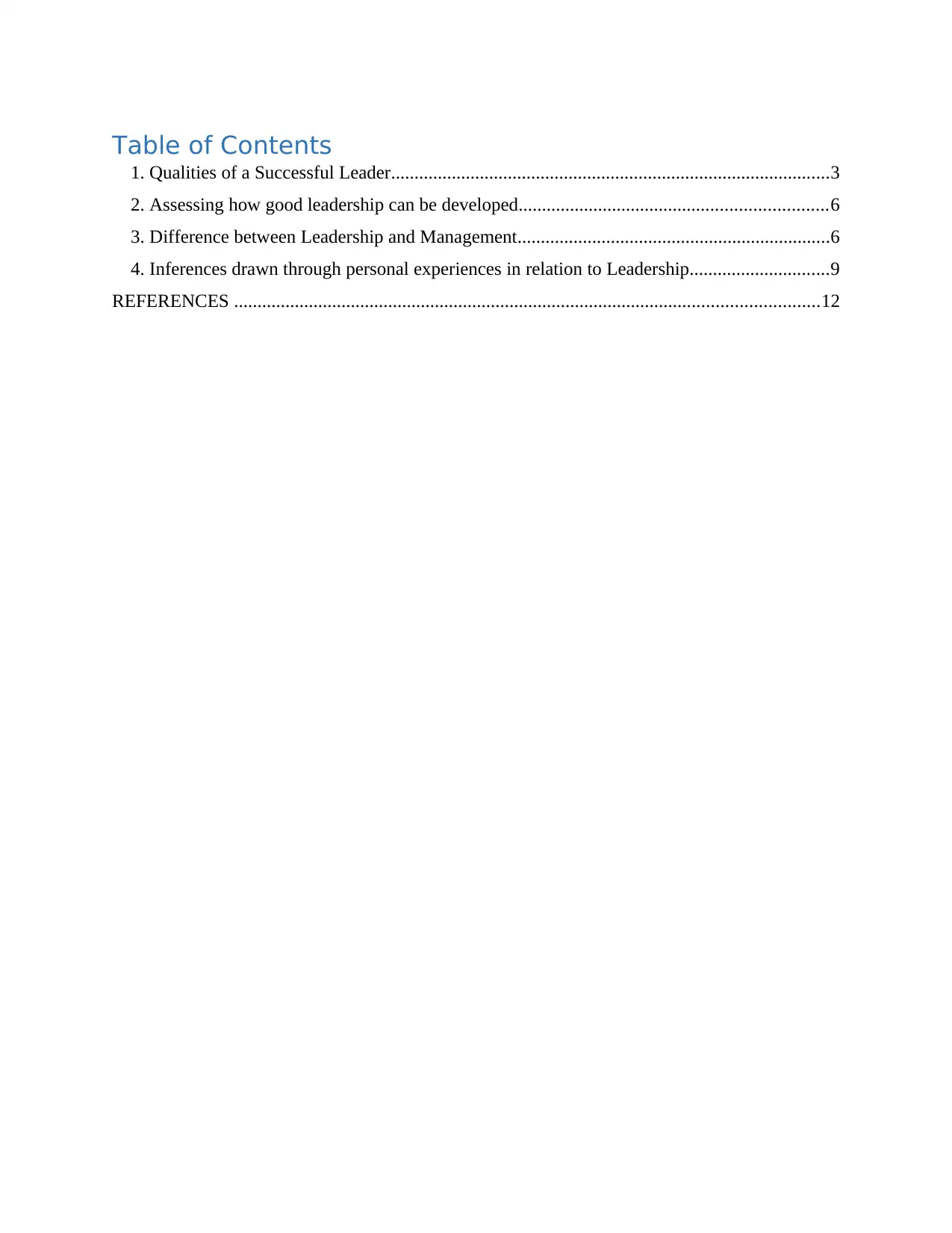
Table of Contents
1. Qualities of a Successful Leader..............................................................................................3
2. Assessing how good leadership can be developed..................................................................6
3. Difference between Leadership and Management...................................................................6
4. Inferences drawn through personal experiences in relation to Leadership..............................9
REFERENCES .............................................................................................................................12
1. Qualities of a Successful Leader..............................................................................................3
2. Assessing how good leadership can be developed..................................................................6
3. Difference between Leadership and Management...................................................................6
4. Inferences drawn through personal experiences in relation to Leadership..............................9
REFERENCES .............................................................................................................................12
⊘ This is a preview!⊘
Do you want full access?
Subscribe today to unlock all pages.

Trusted by 1+ million students worldwide
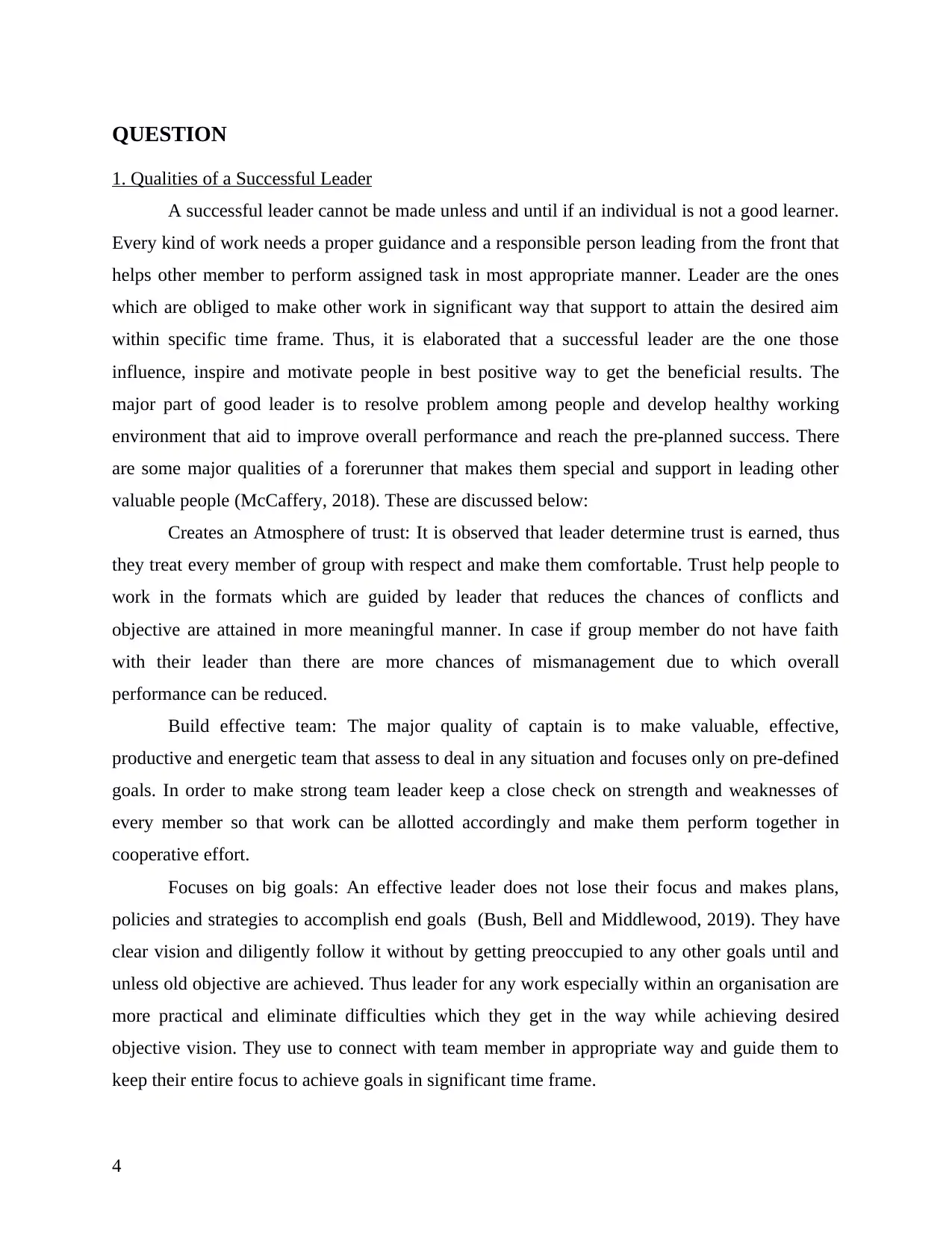
QUESTION
1. Qualities of a Successful Leader
A successful leader cannot be made unless and until if an individual is not a good learner.
Every kind of work needs a proper guidance and a responsible person leading from the front that
helps other member to perform assigned task in most appropriate manner. Leader are the ones
which are obliged to make other work in significant way that support to attain the desired aim
within specific time frame. Thus, it is elaborated that a successful leader are the one those
influence, inspire and motivate people in best positive way to get the beneficial results. The
major part of good leader is to resolve problem among people and develop healthy working
environment that aid to improve overall performance and reach the pre-planned success. There
are some major qualities of a forerunner that makes them special and support in leading other
valuable people (McCaffery, 2018). These are discussed below:
Creates an Atmosphere of trust: It is observed that leader determine trust is earned, thus
they treat every member of group with respect and make them comfortable. Trust help people to
work in the formats which are guided by leader that reduces the chances of conflicts and
objective are attained in more meaningful manner. In case if group member do not have faith
with their leader than there are more chances of mismanagement due to which overall
performance can be reduced.
Build effective team: The major quality of captain is to make valuable, effective,
productive and energetic team that assess to deal in any situation and focuses only on pre-defined
goals. In order to make strong team leader keep a close check on strength and weaknesses of
every member so that work can be allotted accordingly and make them perform together in
cooperative effort.
Focuses on big goals: An effective leader does not lose their focus and makes plans,
policies and strategies to accomplish end goals (Bush, Bell and Middlewood, 2019). They have
clear vision and diligently follow it without by getting preoccupied to any other goals until and
unless old objective are achieved. Thus leader for any work especially within an organisation are
more practical and eliminate difficulties which they get in the way while achieving desired
objective vision. They use to connect with team member in appropriate way and guide them to
keep their entire focus to achieve goals in significant time frame.
4
1. Qualities of a Successful Leader
A successful leader cannot be made unless and until if an individual is not a good learner.
Every kind of work needs a proper guidance and a responsible person leading from the front that
helps other member to perform assigned task in most appropriate manner. Leader are the ones
which are obliged to make other work in significant way that support to attain the desired aim
within specific time frame. Thus, it is elaborated that a successful leader are the one those
influence, inspire and motivate people in best positive way to get the beneficial results. The
major part of good leader is to resolve problem among people and develop healthy working
environment that aid to improve overall performance and reach the pre-planned success. There
are some major qualities of a forerunner that makes them special and support in leading other
valuable people (McCaffery, 2018). These are discussed below:
Creates an Atmosphere of trust: It is observed that leader determine trust is earned, thus
they treat every member of group with respect and make them comfortable. Trust help people to
work in the formats which are guided by leader that reduces the chances of conflicts and
objective are attained in more meaningful manner. In case if group member do not have faith
with their leader than there are more chances of mismanagement due to which overall
performance can be reduced.
Build effective team: The major quality of captain is to make valuable, effective,
productive and energetic team that assess to deal in any situation and focuses only on pre-defined
goals. In order to make strong team leader keep a close check on strength and weaknesses of
every member so that work can be allotted accordingly and make them perform together in
cooperative effort.
Focuses on big goals: An effective leader does not lose their focus and makes plans,
policies and strategies to accomplish end goals (Bush, Bell and Middlewood, 2019). They have
clear vision and diligently follow it without by getting preoccupied to any other goals until and
unless old objective are achieved. Thus leader for any work especially within an organisation are
more practical and eliminate difficulties which they get in the way while achieving desired
objective vision. They use to connect with team member in appropriate way and guide them to
keep their entire focus to achieve goals in significant time frame.
4
Paraphrase This Document
Need a fresh take? Get an instant paraphrase of this document with our AI Paraphraser
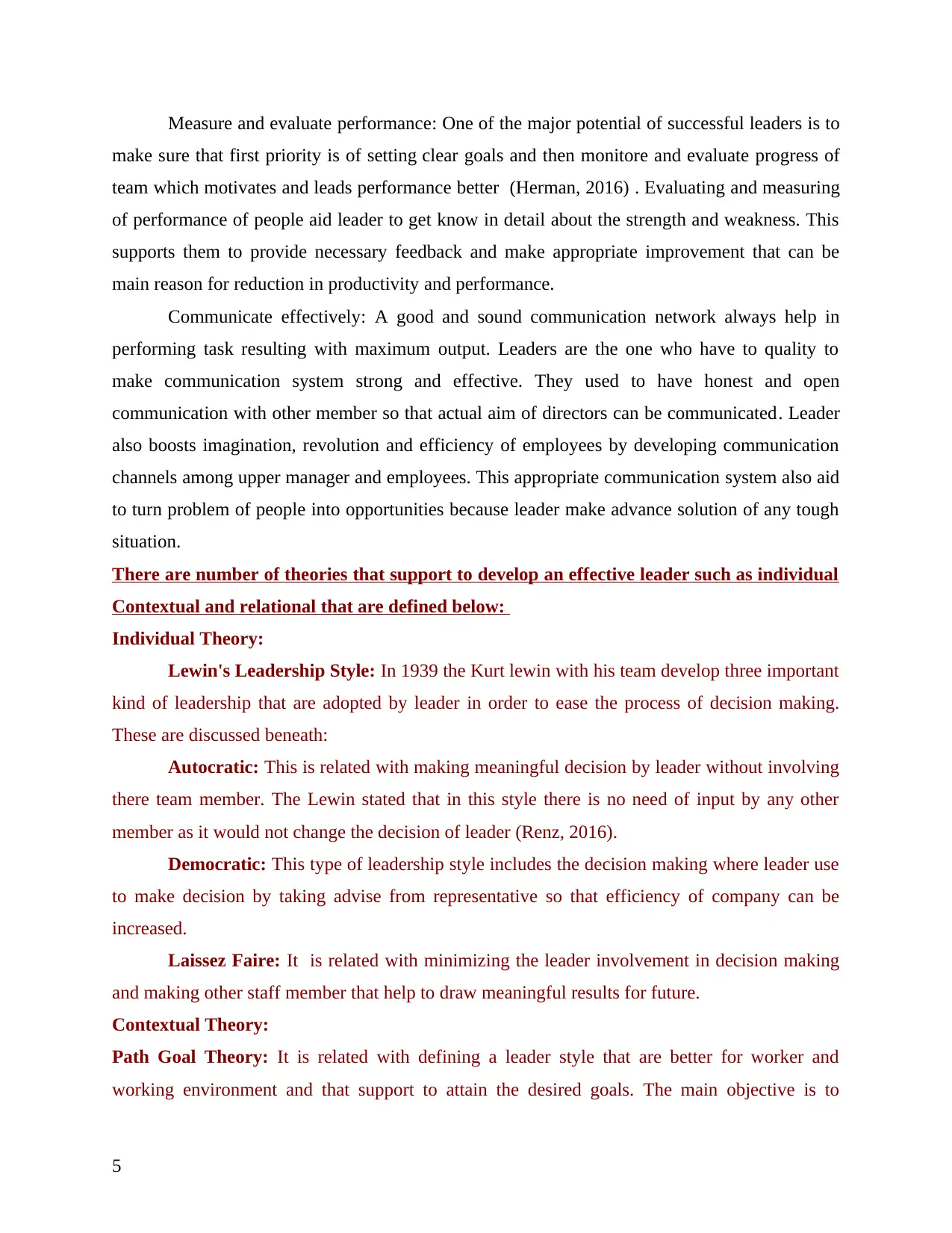
Measure and evaluate performance: One of the major potential of successful leaders is to
make sure that first priority is of setting clear goals and then monitore and evaluate progress of
team which motivates and leads performance better (Herman, 2016) . Evaluating and measuring
of performance of people aid leader to get know in detail about the strength and weakness. This
supports them to provide necessary feedback and make appropriate improvement that can be
main reason for reduction in productivity and performance.
Communicate effectively: A good and sound communication network always help in
performing task resulting with maximum output. Leaders are the one who have to quality to
make communication system strong and effective. They used to have honest and open
communication with other member so that actual aim of directors can be communicated. Leader
also boosts imagination, revolution and efficiency of employees by developing communication
channels among upper manager and employees. This appropriate communication system also aid
to turn problem of people into opportunities because leader make advance solution of any tough
situation.
There are number of theories that support to develop an effective leader such as individual
Contextual and relational that are defined below:
Individual Theory:
Lewin's Leadership Style: In 1939 the Kurt lewin with his team develop three important
kind of leadership that are adopted by leader in order to ease the process of decision making.
These are discussed beneath:
Autocratic: This is related with making meaningful decision by leader without involving
there team member. The Lewin stated that in this style there is no need of input by any other
member as it would not change the decision of leader (Renz, 2016).
Democratic: This type of leadership style includes the decision making where leader use
to make decision by taking advise from representative so that efficiency of company can be
increased.
Laissez Faire: It is related with minimizing the leader involvement in decision making
and making other staff member that help to draw meaningful results for future.
Contextual Theory:
Path Goal Theory: It is related with defining a leader style that are better for worker and
working environment and that support to attain the desired goals. The main objective is to
5
make sure that first priority is of setting clear goals and then monitore and evaluate progress of
team which motivates and leads performance better (Herman, 2016) . Evaluating and measuring
of performance of people aid leader to get know in detail about the strength and weakness. This
supports them to provide necessary feedback and make appropriate improvement that can be
main reason for reduction in productivity and performance.
Communicate effectively: A good and sound communication network always help in
performing task resulting with maximum output. Leaders are the one who have to quality to
make communication system strong and effective. They used to have honest and open
communication with other member so that actual aim of directors can be communicated. Leader
also boosts imagination, revolution and efficiency of employees by developing communication
channels among upper manager and employees. This appropriate communication system also aid
to turn problem of people into opportunities because leader make advance solution of any tough
situation.
There are number of theories that support to develop an effective leader such as individual
Contextual and relational that are defined below:
Individual Theory:
Lewin's Leadership Style: In 1939 the Kurt lewin with his team develop three important
kind of leadership that are adopted by leader in order to ease the process of decision making.
These are discussed beneath:
Autocratic: This is related with making meaningful decision by leader without involving
there team member. The Lewin stated that in this style there is no need of input by any other
member as it would not change the decision of leader (Renz, 2016).
Democratic: This type of leadership style includes the decision making where leader use
to make decision by taking advise from representative so that efficiency of company can be
increased.
Laissez Faire: It is related with minimizing the leader involvement in decision making
and making other staff member that help to draw meaningful results for future.
Contextual Theory:
Path Goal Theory: It is related with defining a leader style that are better for worker and
working environment and that support to attain the desired goals. The main objective is to
5
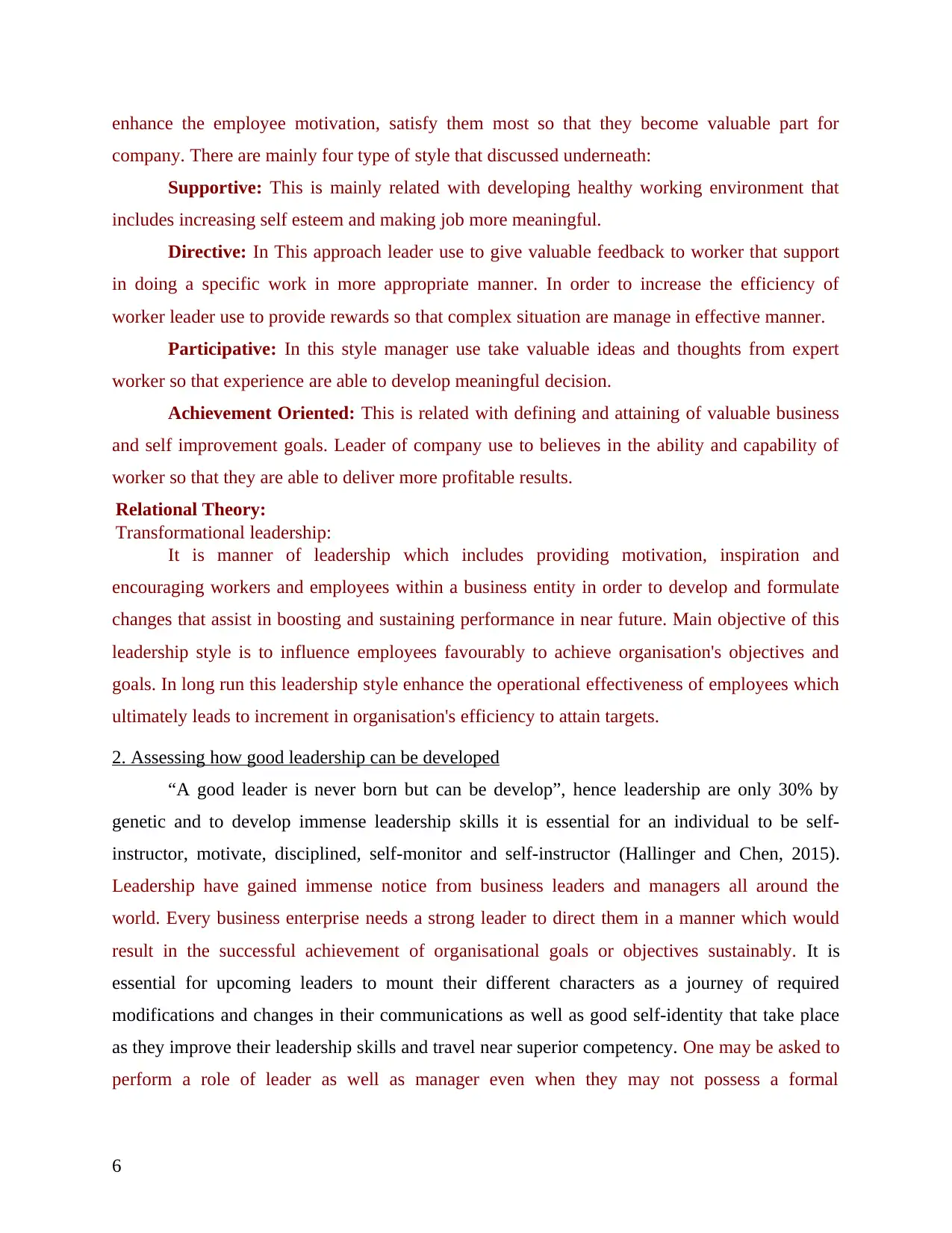
enhance the employee motivation, satisfy them most so that they become valuable part for
company. There are mainly four type of style that discussed underneath:
Supportive: This is mainly related with developing healthy working environment that
includes increasing self esteem and making job more meaningful.
Directive: In This approach leader use to give valuable feedback to worker that support
in doing a specific work in more appropriate manner. In order to increase the efficiency of
worker leader use to provide rewards so that complex situation are manage in effective manner.
Participative: In this style manager use take valuable ideas and thoughts from expert
worker so that experience are able to develop meaningful decision.
Achievement Oriented: This is related with defining and attaining of valuable business
and self improvement goals. Leader of company use to believes in the ability and capability of
worker so that they are able to deliver more profitable results.
Relational Theory:
Transformational leadership:
It is manner of leadership which includes providing motivation, inspiration and
encouraging workers and employees within a business entity in order to develop and formulate
changes that assist in boosting and sustaining performance in near future. Main objective of this
leadership style is to influence employees favourably to achieve organisation's objectives and
goals. In long run this leadership style enhance the operational effectiveness of employees which
ultimately leads to increment in organisation's efficiency to attain targets.
2. Assessing how good leadership can be developed
“A good leader is never born but can be develop”, hence leadership are only 30% by
genetic and to develop immense leadership skills it is essential for an individual to be self-
instructor, motivate, disciplined, self-monitor and self-instructor (Hallinger and Chen, 2015).
Leadership have gained immense notice from business leaders and managers all around the
world. Every business enterprise needs a strong leader to direct them in a manner which would
result in the successful achievement of organisational goals or objectives sustainably. It is
essential for upcoming leaders to mount their different characters as a journey of required
modifications and changes in their communications as well as good self-identity that take place
as they improve their leadership skills and travel near superior competency. One may be asked to
perform a role of leader as well as manager even when they may not possess a formal
6
company. There are mainly four type of style that discussed underneath:
Supportive: This is mainly related with developing healthy working environment that
includes increasing self esteem and making job more meaningful.
Directive: In This approach leader use to give valuable feedback to worker that support
in doing a specific work in more appropriate manner. In order to increase the efficiency of
worker leader use to provide rewards so that complex situation are manage in effective manner.
Participative: In this style manager use take valuable ideas and thoughts from expert
worker so that experience are able to develop meaningful decision.
Achievement Oriented: This is related with defining and attaining of valuable business
and self improvement goals. Leader of company use to believes in the ability and capability of
worker so that they are able to deliver more profitable results.
Relational Theory:
Transformational leadership:
It is manner of leadership which includes providing motivation, inspiration and
encouraging workers and employees within a business entity in order to develop and formulate
changes that assist in boosting and sustaining performance in near future. Main objective of this
leadership style is to influence employees favourably to achieve organisation's objectives and
goals. In long run this leadership style enhance the operational effectiveness of employees which
ultimately leads to increment in organisation's efficiency to attain targets.
2. Assessing how good leadership can be developed
“A good leader is never born but can be develop”, hence leadership are only 30% by
genetic and to develop immense leadership skills it is essential for an individual to be self-
instructor, motivate, disciplined, self-monitor and self-instructor (Hallinger and Chen, 2015).
Leadership have gained immense notice from business leaders and managers all around the
world. Every business enterprise needs a strong leader to direct them in a manner which would
result in the successful achievement of organisational goals or objectives sustainably. It is
essential for upcoming leaders to mount their different characters as a journey of required
modifications and changes in their communications as well as good self-identity that take place
as they improve their leadership skills and travel near superior competency. One may be asked to
perform a role of leader as well as manager even when they may not possess a formal
6
⊘ This is a preview!⊘
Do you want full access?
Subscribe today to unlock all pages.

Trusted by 1+ million students worldwide
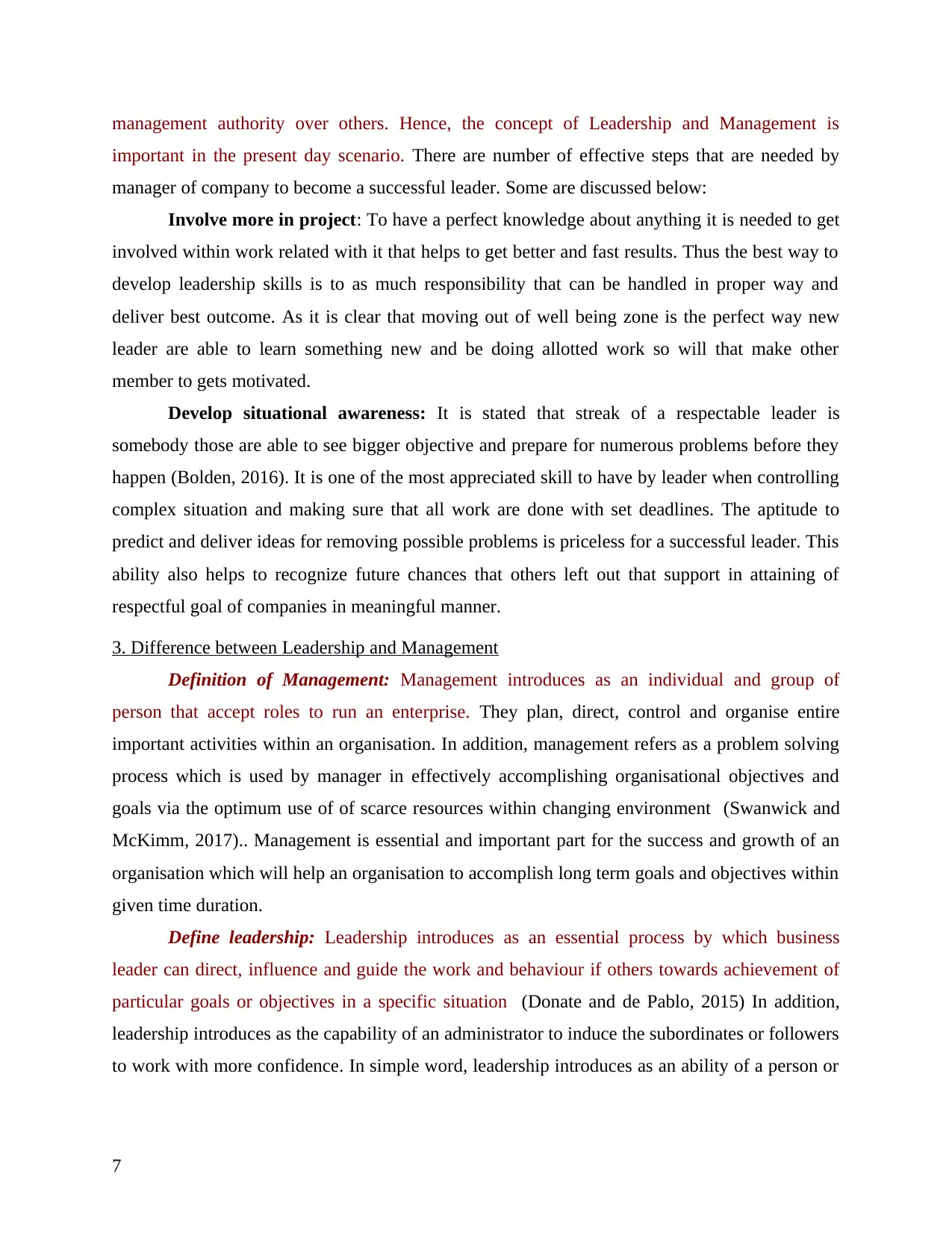
management authority over others. Hence, the concept of Leadership and Management is
important in the present day scenario. There are number of effective steps that are needed by
manager of company to become a successful leader. Some are discussed below:
Involve more in project: To have a perfect knowledge about anything it is needed to get
involved within work related with it that helps to get better and fast results. Thus the best way to
develop leadership skills is to as much responsibility that can be handled in proper way and
deliver best outcome. As it is clear that moving out of well being zone is the perfect way new
leader are able to learn something new and be doing allotted work so will that make other
member to gets motivated.
Develop situational awareness: It is stated that streak of a respectable leader is
somebody those are able to see bigger objective and prepare for numerous problems before they
happen (Bolden, 2016). It is one of the most appreciated skill to have by leader when controlling
complex situation and making sure that all work are done with set deadlines. The aptitude to
predict and deliver ideas for removing possible problems is priceless for a successful leader. This
ability also helps to recognize future chances that others left out that support in attaining of
respectful goal of companies in meaningful manner.
3. Difference between Leadership and Management
Definition of Management: Management introduces as an individual and group of
person that accept roles to run an enterprise. They plan, direct, control and organise entire
important activities within an organisation. In addition, management refers as a problem solving
process which is used by manager in effectively accomplishing organisational objectives and
goals via the optimum use of of scarce resources within changing environment (Swanwick and
McKimm, 2017).. Management is essential and important part for the success and growth of an
organisation which will help an organisation to accomplish long term goals and objectives within
given time duration.
Define leadership: Leadership introduces as an essential process by which business
leader can direct, influence and guide the work and behaviour if others towards achievement of
particular goals or objectives in a specific situation (Donate and de Pablo, 2015) In addition,
leadership introduces as the capability of an administrator to induce the subordinates or followers
to work with more confidence. In simple word, leadership introduces as an ability of a person or
7
important in the present day scenario. There are number of effective steps that are needed by
manager of company to become a successful leader. Some are discussed below:
Involve more in project: To have a perfect knowledge about anything it is needed to get
involved within work related with it that helps to get better and fast results. Thus the best way to
develop leadership skills is to as much responsibility that can be handled in proper way and
deliver best outcome. As it is clear that moving out of well being zone is the perfect way new
leader are able to learn something new and be doing allotted work so will that make other
member to gets motivated.
Develop situational awareness: It is stated that streak of a respectable leader is
somebody those are able to see bigger objective and prepare for numerous problems before they
happen (Bolden, 2016). It is one of the most appreciated skill to have by leader when controlling
complex situation and making sure that all work are done with set deadlines. The aptitude to
predict and deliver ideas for removing possible problems is priceless for a successful leader. This
ability also helps to recognize future chances that others left out that support in attaining of
respectful goal of companies in meaningful manner.
3. Difference between Leadership and Management
Definition of Management: Management introduces as an individual and group of
person that accept roles to run an enterprise. They plan, direct, control and organise entire
important activities within an organisation. In addition, management refers as a problem solving
process which is used by manager in effectively accomplishing organisational objectives and
goals via the optimum use of of scarce resources within changing environment (Swanwick and
McKimm, 2017).. Management is essential and important part for the success and growth of an
organisation which will help an organisation to accomplish long term goals and objectives within
given time duration.
Define leadership: Leadership introduces as an essential process by which business
leader can direct, influence and guide the work and behaviour if others towards achievement of
particular goals or objectives in a specific situation (Donate and de Pablo, 2015) In addition,
leadership introduces as the capability of an administrator to induce the subordinates or followers
to work with more confidence. In simple word, leadership introduces as an ability of a person or
7
Paraphrase This Document
Need a fresh take? Get an instant paraphrase of this document with our AI Paraphraser
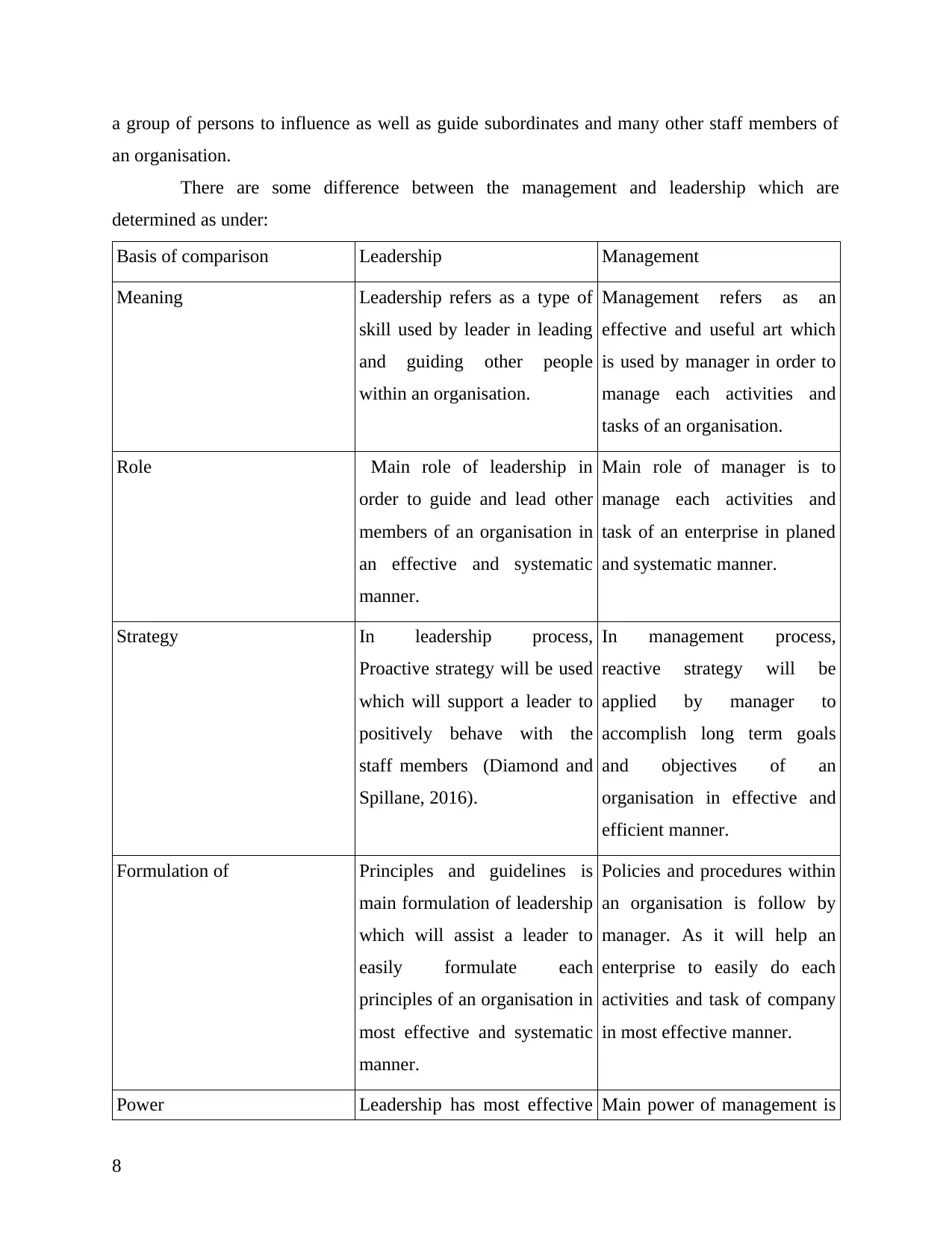
a group of persons to influence as well as guide subordinates and many other staff members of
an organisation.
There are some difference between the management and leadership which are
determined as under:
Basis of comparison Leadership Management
Meaning Leadership refers as a type of
skill used by leader in leading
and guiding other people
within an organisation.
Management refers as an
effective and useful art which
is used by manager in order to
manage each activities and
tasks of an organisation.
Role Main role of leadership in
order to guide and lead other
members of an organisation in
an effective and systematic
manner.
Main role of manager is to
manage each activities and
task of an enterprise in planed
and systematic manner.
Strategy In leadership process,
Proactive strategy will be used
which will support a leader to
positively behave with the
staff members (Diamond and
Spillane, 2016).
In management process,
reactive strategy will be
applied by manager to
accomplish long term goals
and objectives of an
organisation in effective and
efficient manner.
Formulation of Principles and guidelines is
main formulation of leadership
which will assist a leader to
easily formulate each
principles of an organisation in
most effective and systematic
manner.
Policies and procedures within
an organisation is follow by
manager. As it will help an
enterprise to easily do each
activities and task of company
in most effective manner.
Power Leadership has most effective Main power of management is
8
an organisation.
There are some difference between the management and leadership which are
determined as under:
Basis of comparison Leadership Management
Meaning Leadership refers as a type of
skill used by leader in leading
and guiding other people
within an organisation.
Management refers as an
effective and useful art which
is used by manager in order to
manage each activities and
tasks of an organisation.
Role Main role of leadership in
order to guide and lead other
members of an organisation in
an effective and systematic
manner.
Main role of manager is to
manage each activities and
task of an enterprise in planed
and systematic manner.
Strategy In leadership process,
Proactive strategy will be used
which will support a leader to
positively behave with the
staff members (Diamond and
Spillane, 2016).
In management process,
reactive strategy will be
applied by manager to
accomplish long term goals
and objectives of an
organisation in effective and
efficient manner.
Formulation of Principles and guidelines is
main formulation of leadership
which will assist a leader to
easily formulate each
principles of an organisation in
most effective and systematic
manner.
Policies and procedures within
an organisation is follow by
manager. As it will help an
enterprise to easily do each
activities and task of company
in most effective manner.
Power Leadership has most effective Main power of management is
8
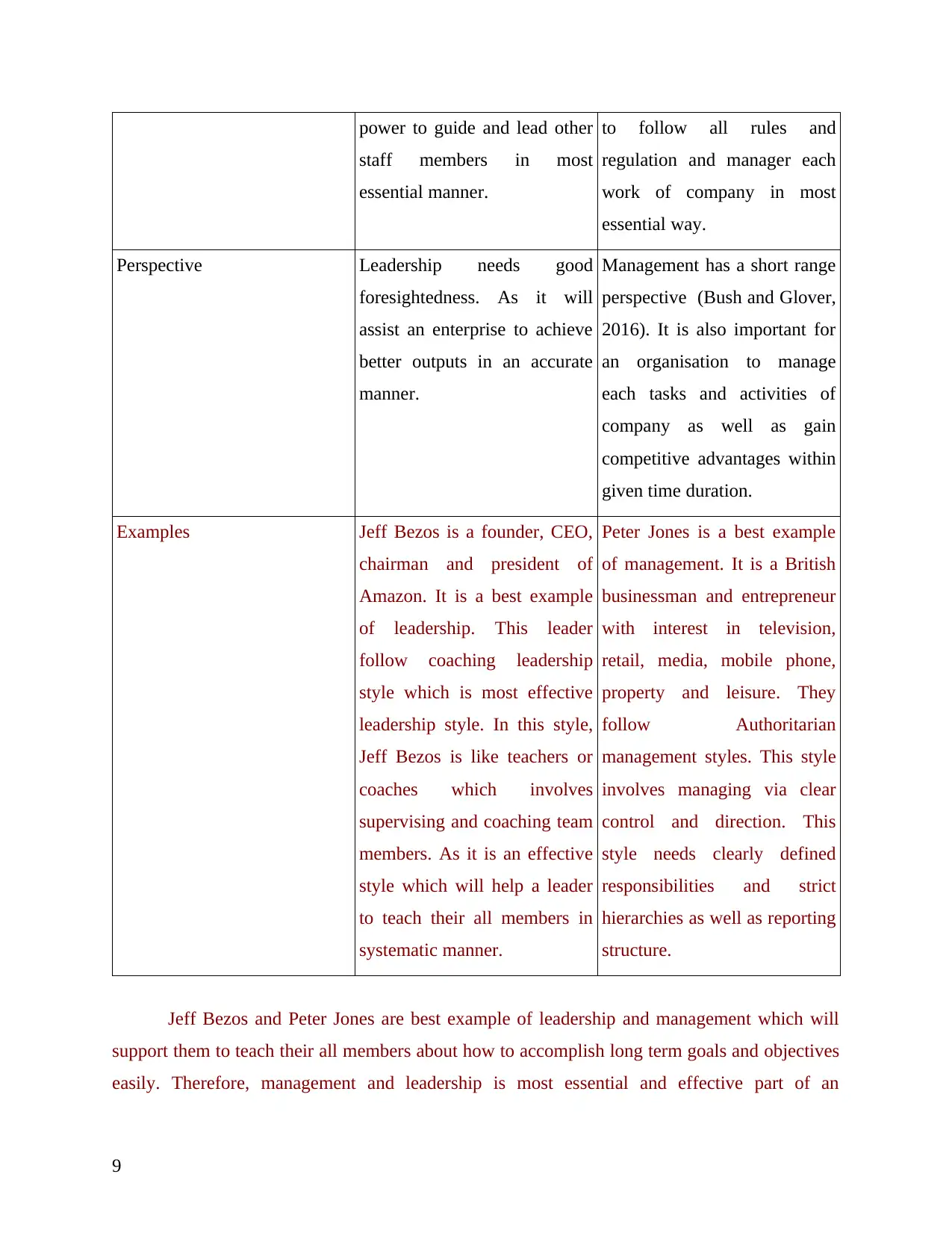
power to guide and lead other
staff members in most
essential manner.
to follow all rules and
regulation and manager each
work of company in most
essential way.
Perspective Leadership needs good
foresightedness. As it will
assist an enterprise to achieve
better outputs in an accurate
manner.
Management has a short range
perspective (Bush and Glover,
2016). It is also important for
an organisation to manage
each tasks and activities of
company as well as gain
competitive advantages within
given time duration.
Examples Jeff Bezos is a founder, CEO,
chairman and president of
Amazon. It is a best example
of leadership. This leader
follow coaching leadership
style which is most effective
leadership style. In this style,
Jeff Bezos is like teachers or
coaches which involves
supervising and coaching team
members. As it is an effective
style which will help a leader
to teach their all members in
systematic manner.
Peter Jones is a best example
of management. It is a British
businessman and entrepreneur
with interest in television,
retail, media, mobile phone,
property and leisure. They
follow Authoritarian
management styles. This style
involves managing via clear
control and direction. This
style needs clearly defined
responsibilities and strict
hierarchies as well as reporting
structure.
Jeff Bezos and Peter Jones are best example of leadership and management which will
support them to teach their all members about how to accomplish long term goals and objectives
easily. Therefore, management and leadership is most essential and effective part of an
9
staff members in most
essential manner.
to follow all rules and
regulation and manager each
work of company in most
essential way.
Perspective Leadership needs good
foresightedness. As it will
assist an enterprise to achieve
better outputs in an accurate
manner.
Management has a short range
perspective (Bush and Glover,
2016). It is also important for
an organisation to manage
each tasks and activities of
company as well as gain
competitive advantages within
given time duration.
Examples Jeff Bezos is a founder, CEO,
chairman and president of
Amazon. It is a best example
of leadership. This leader
follow coaching leadership
style which is most effective
leadership style. In this style,
Jeff Bezos is like teachers or
coaches which involves
supervising and coaching team
members. As it is an effective
style which will help a leader
to teach their all members in
systematic manner.
Peter Jones is a best example
of management. It is a British
businessman and entrepreneur
with interest in television,
retail, media, mobile phone,
property and leisure. They
follow Authoritarian
management styles. This style
involves managing via clear
control and direction. This
style needs clearly defined
responsibilities and strict
hierarchies as well as reporting
structure.
Jeff Bezos and Peter Jones are best example of leadership and management which will
support them to teach their all members about how to accomplish long term goals and objectives
easily. Therefore, management and leadership is most essential and effective part of an
9
⊘ This is a preview!⊘
Do you want full access?
Subscribe today to unlock all pages.

Trusted by 1+ million students worldwide
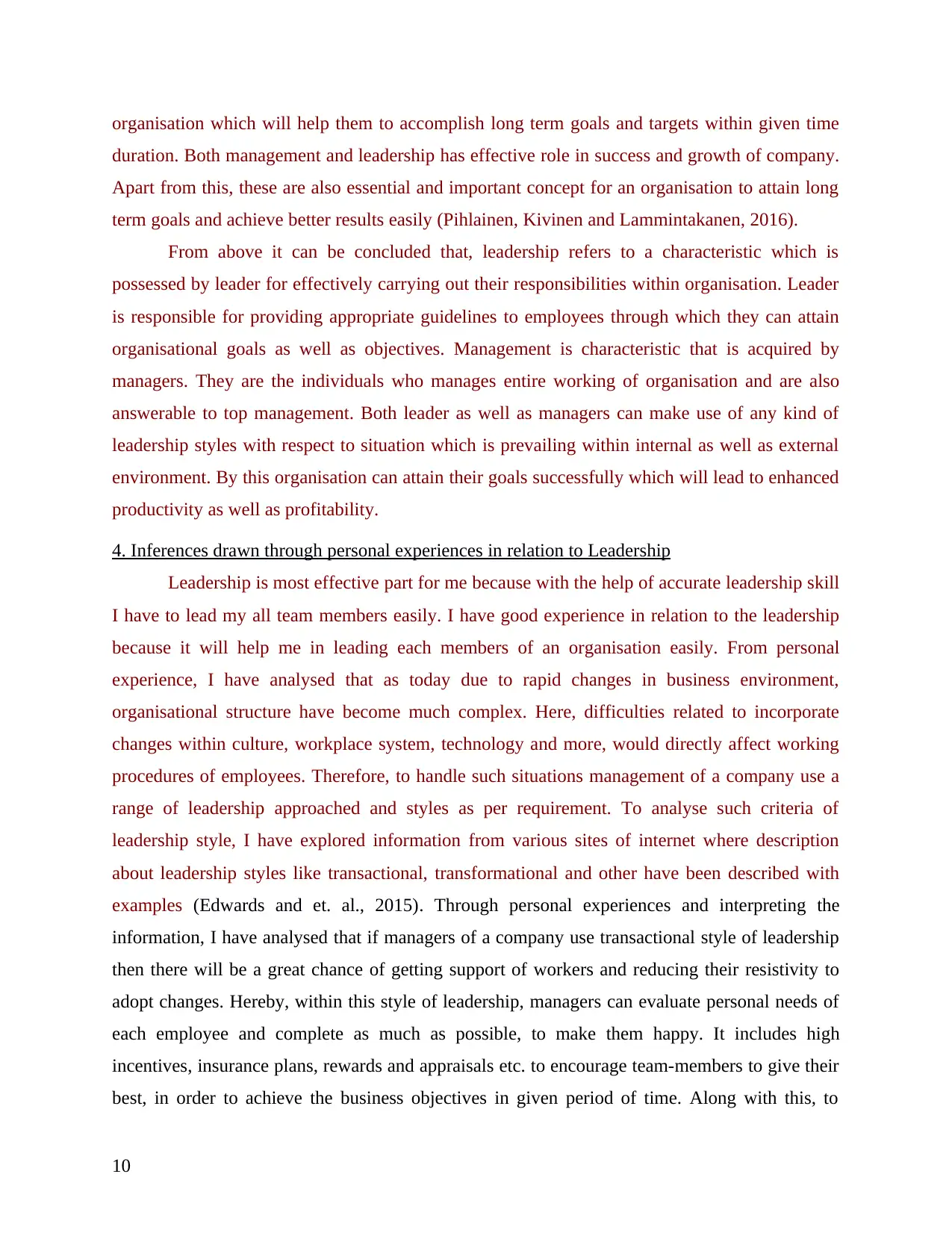
organisation which will help them to accomplish long term goals and targets within given time
duration. Both management and leadership has effective role in success and growth of company.
Apart from this, these are also essential and important concept for an organisation to attain long
term goals and achieve better results easily (Pihlainen, Kivinen and Lammintakanen, 2016).
From above it can be concluded that, leadership refers to a characteristic which is
possessed by leader for effectively carrying out their responsibilities within organisation. Leader
is responsible for providing appropriate guidelines to employees through which they can attain
organisational goals as well as objectives. Management is characteristic that is acquired by
managers. They are the individuals who manages entire working of organisation and are also
answerable to top management. Both leader as well as managers can make use of any kind of
leadership styles with respect to situation which is prevailing within internal as well as external
environment. By this organisation can attain their goals successfully which will lead to enhanced
productivity as well as profitability.
4. Inferences drawn through personal experiences in relation to Leadership
Leadership is most effective part for me because with the help of accurate leadership skill
I have to lead my all team members easily. I have good experience in relation to the leadership
because it will help me in leading each members of an organisation easily. From personal
experience, I have analysed that as today due to rapid changes in business environment,
organisational structure have become much complex. Here, difficulties related to incorporate
changes within culture, workplace system, technology and more, would directly affect working
procedures of employees. Therefore, to handle such situations management of a company use a
range of leadership approached and styles as per requirement. To analyse such criteria of
leadership style, I have explored information from various sites of internet where description
about leadership styles like transactional, transformational and other have been described with
examples (Edwards and et. al., 2015). Through personal experiences and interpreting the
information, I have analysed that if managers of a company use transactional style of leadership
then there will be a great chance of getting support of workers and reducing their resistivity to
adopt changes. Hereby, within this style of leadership, managers can evaluate personal needs of
each employee and complete as much as possible, to make them happy. It includes high
incentives, insurance plans, rewards and appraisals etc. to encourage team-members to give their
best, in order to achieve the business objectives in given period of time. Along with this, to
10
duration. Both management and leadership has effective role in success and growth of company.
Apart from this, these are also essential and important concept for an organisation to attain long
term goals and achieve better results easily (Pihlainen, Kivinen and Lammintakanen, 2016).
From above it can be concluded that, leadership refers to a characteristic which is
possessed by leader for effectively carrying out their responsibilities within organisation. Leader
is responsible for providing appropriate guidelines to employees through which they can attain
organisational goals as well as objectives. Management is characteristic that is acquired by
managers. They are the individuals who manages entire working of organisation and are also
answerable to top management. Both leader as well as managers can make use of any kind of
leadership styles with respect to situation which is prevailing within internal as well as external
environment. By this organisation can attain their goals successfully which will lead to enhanced
productivity as well as profitability.
4. Inferences drawn through personal experiences in relation to Leadership
Leadership is most effective part for me because with the help of accurate leadership skill
I have to lead my all team members easily. I have good experience in relation to the leadership
because it will help me in leading each members of an organisation easily. From personal
experience, I have analysed that as today due to rapid changes in business environment,
organisational structure have become much complex. Here, difficulties related to incorporate
changes within culture, workplace system, technology and more, would directly affect working
procedures of employees. Therefore, to handle such situations management of a company use a
range of leadership approached and styles as per requirement. To analyse such criteria of
leadership style, I have explored information from various sites of internet where description
about leadership styles like transactional, transformational and other have been described with
examples (Edwards and et. al., 2015). Through personal experiences and interpreting the
information, I have analysed that if managers of a company use transactional style of leadership
then there will be a great chance of getting support of workers and reducing their resistivity to
adopt changes. Hereby, within this style of leadership, managers can evaluate personal needs of
each employee and complete as much as possible, to make them happy. It includes high
incentives, insurance plans, rewards and appraisals etc. to encourage team-members to give their
best, in order to achieve the business objectives in given period of time. Along with this, to
10
Paraphrase This Document
Need a fresh take? Get an instant paraphrase of this document with our AI Paraphraser
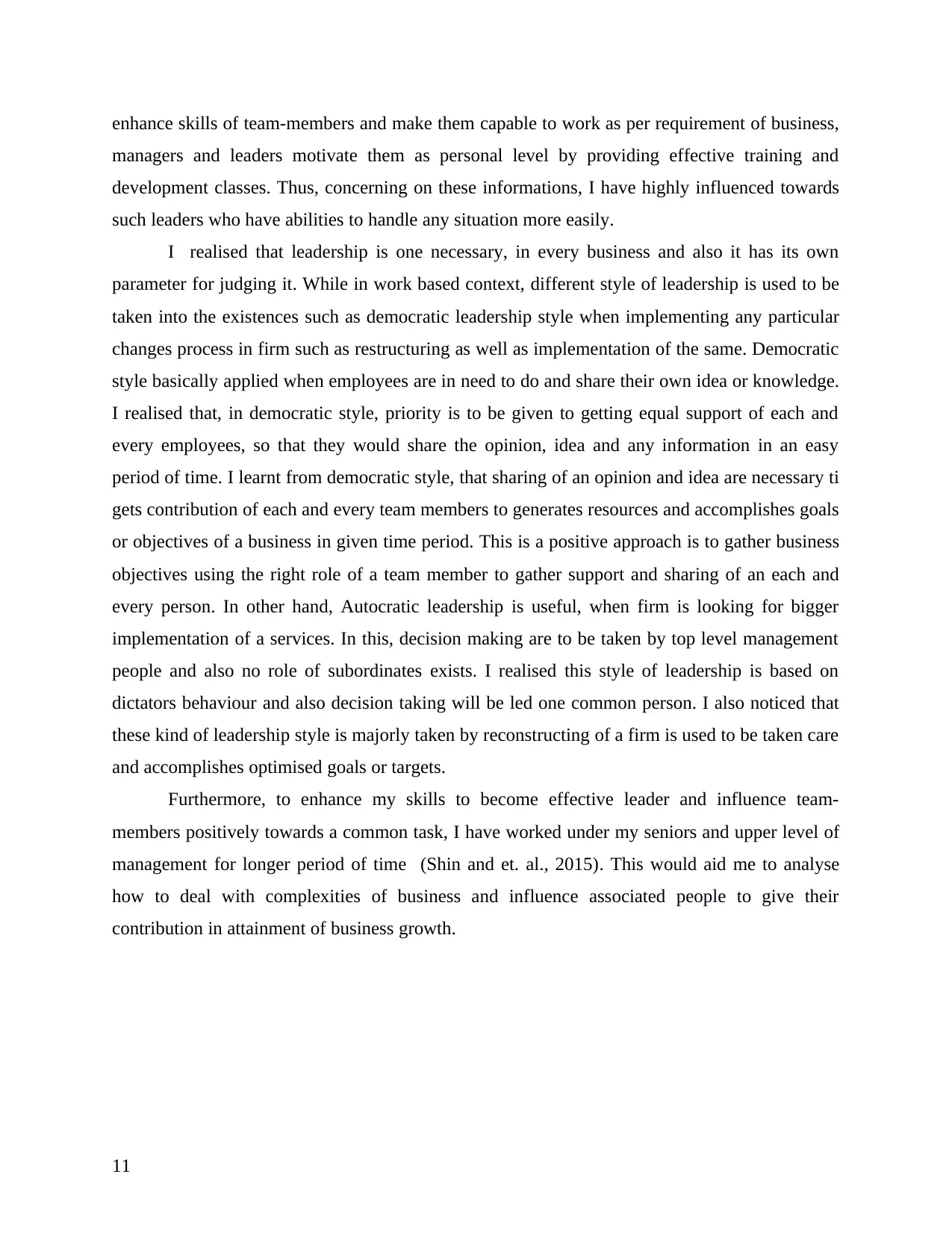
enhance skills of team-members and make them capable to work as per requirement of business,
managers and leaders motivate them as personal level by providing effective training and
development classes. Thus, concerning on these informations, I have highly influenced towards
such leaders who have abilities to handle any situation more easily.
I realised that leadership is one necessary, in every business and also it has its own
parameter for judging it. While in work based context, different style of leadership is used to be
taken into the existences such as democratic leadership style when implementing any particular
changes process in firm such as restructuring as well as implementation of the same. Democratic
style basically applied when employees are in need to do and share their own idea or knowledge.
I realised that, in democratic style, priority is to be given to getting equal support of each and
every employees, so that they would share the opinion, idea and any information in an easy
period of time. I learnt from democratic style, that sharing of an opinion and idea are necessary ti
gets contribution of each and every team members to generates resources and accomplishes goals
or objectives of a business in given time period. This is a positive approach is to gather business
objectives using the right role of a team member to gather support and sharing of an each and
every person. In other hand, Autocratic leadership is useful, when firm is looking for bigger
implementation of a services. In this, decision making are to be taken by top level management
people and also no role of subordinates exists. I realised this style of leadership is based on
dictators behaviour and also decision taking will be led one common person. I also noticed that
these kind of leadership style is majorly taken by reconstructing of a firm is used to be taken care
and accomplishes optimised goals or targets.
Furthermore, to enhance my skills to become effective leader and influence team-
members positively towards a common task, I have worked under my seniors and upper level of
management for longer period of time (Shin and et. al., 2015). This would aid me to analyse
how to deal with complexities of business and influence associated people to give their
contribution in attainment of business growth.
11
managers and leaders motivate them as personal level by providing effective training and
development classes. Thus, concerning on these informations, I have highly influenced towards
such leaders who have abilities to handle any situation more easily.
I realised that leadership is one necessary, in every business and also it has its own
parameter for judging it. While in work based context, different style of leadership is used to be
taken into the existences such as democratic leadership style when implementing any particular
changes process in firm such as restructuring as well as implementation of the same. Democratic
style basically applied when employees are in need to do and share their own idea or knowledge.
I realised that, in democratic style, priority is to be given to getting equal support of each and
every employees, so that they would share the opinion, idea and any information in an easy
period of time. I learnt from democratic style, that sharing of an opinion and idea are necessary ti
gets contribution of each and every team members to generates resources and accomplishes goals
or objectives of a business in given time period. This is a positive approach is to gather business
objectives using the right role of a team member to gather support and sharing of an each and
every person. In other hand, Autocratic leadership is useful, when firm is looking for bigger
implementation of a services. In this, decision making are to be taken by top level management
people and also no role of subordinates exists. I realised this style of leadership is based on
dictators behaviour and also decision taking will be led one common person. I also noticed that
these kind of leadership style is majorly taken by reconstructing of a firm is used to be taken care
and accomplishes optimised goals or targets.
Furthermore, to enhance my skills to become effective leader and influence team-
members positively towards a common task, I have worked under my seniors and upper level of
management for longer period of time (Shin and et. al., 2015). This would aid me to analyse
how to deal with complexities of business and influence associated people to give their
contribution in attainment of business growth.
11
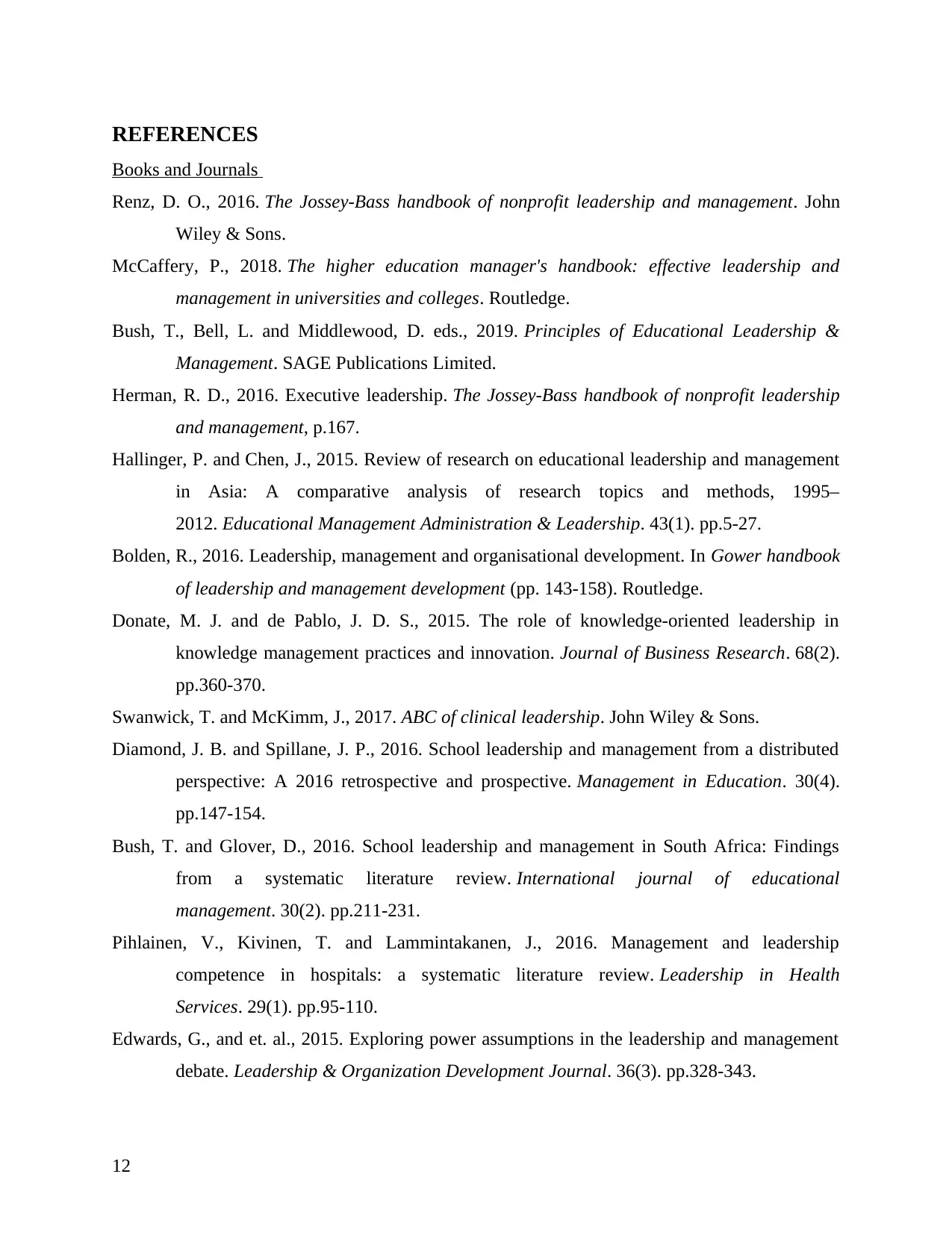
REFERENCES
Books and Journals
Renz, D. O., 2016. The Jossey-Bass handbook of nonprofit leadership and management. John
Wiley & Sons.
McCaffery, P., 2018. The higher education manager's handbook: effective leadership and
management in universities and colleges. Routledge.
Bush, T., Bell, L. and Middlewood, D. eds., 2019. Principles of Educational Leadership &
Management. SAGE Publications Limited.
Herman, R. D., 2016. Executive leadership. The Jossey-Bass handbook of nonprofit leadership
and management, p.167.
Hallinger, P. and Chen, J., 2015. Review of research on educational leadership and management
in Asia: A comparative analysis of research topics and methods, 1995–
2012. Educational Management Administration & Leadership. 43(1). pp.5-27.
Bolden, R., 2016. Leadership, management and organisational development. In Gower handbook
of leadership and management development (pp. 143-158). Routledge.
Donate, M. J. and de Pablo, J. D. S., 2015. The role of knowledge-oriented leadership in
knowledge management practices and innovation. Journal of Business Research. 68(2).
pp.360-370.
Swanwick, T. and McKimm, J., 2017. ABC of clinical leadership. John Wiley & Sons.
Diamond, J. B. and Spillane, J. P., 2016. School leadership and management from a distributed
perspective: A 2016 retrospective and prospective. Management in Education. 30(4).
pp.147-154.
Bush, T. and Glover, D., 2016. School leadership and management in South Africa: Findings
from a systematic literature review. International journal of educational
management. 30(2). pp.211-231.
Pihlainen, V., Kivinen, T. and Lammintakanen, J., 2016. Management and leadership
competence in hospitals: a systematic literature review. Leadership in Health
Services. 29(1). pp.95-110.
Edwards, G., and et. al., 2015. Exploring power assumptions in the leadership and management
debate. Leadership & Organization Development Journal. 36(3). pp.328-343.
12
Books and Journals
Renz, D. O., 2016. The Jossey-Bass handbook of nonprofit leadership and management. John
Wiley & Sons.
McCaffery, P., 2018. The higher education manager's handbook: effective leadership and
management in universities and colleges. Routledge.
Bush, T., Bell, L. and Middlewood, D. eds., 2019. Principles of Educational Leadership &
Management. SAGE Publications Limited.
Herman, R. D., 2016. Executive leadership. The Jossey-Bass handbook of nonprofit leadership
and management, p.167.
Hallinger, P. and Chen, J., 2015. Review of research on educational leadership and management
in Asia: A comparative analysis of research topics and methods, 1995–
2012. Educational Management Administration & Leadership. 43(1). pp.5-27.
Bolden, R., 2016. Leadership, management and organisational development. In Gower handbook
of leadership and management development (pp. 143-158). Routledge.
Donate, M. J. and de Pablo, J. D. S., 2015. The role of knowledge-oriented leadership in
knowledge management practices and innovation. Journal of Business Research. 68(2).
pp.360-370.
Swanwick, T. and McKimm, J., 2017. ABC of clinical leadership. John Wiley & Sons.
Diamond, J. B. and Spillane, J. P., 2016. School leadership and management from a distributed
perspective: A 2016 retrospective and prospective. Management in Education. 30(4).
pp.147-154.
Bush, T. and Glover, D., 2016. School leadership and management in South Africa: Findings
from a systematic literature review. International journal of educational
management. 30(2). pp.211-231.
Pihlainen, V., Kivinen, T. and Lammintakanen, J., 2016. Management and leadership
competence in hospitals: a systematic literature review. Leadership in Health
Services. 29(1). pp.95-110.
Edwards, G., and et. al., 2015. Exploring power assumptions in the leadership and management
debate. Leadership & Organization Development Journal. 36(3). pp.328-343.
12
⊘ This is a preview!⊘
Do you want full access?
Subscribe today to unlock all pages.

Trusted by 1+ million students worldwide
1 out of 13
Related Documents
Your All-in-One AI-Powered Toolkit for Academic Success.
+13062052269
info@desklib.com
Available 24*7 on WhatsApp / Email
![[object Object]](/_next/static/media/star-bottom.7253800d.svg)
Unlock your academic potential
Copyright © 2020–2025 A2Z Services. All Rights Reserved. Developed and managed by ZUCOL.




